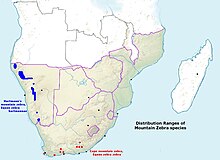Equus zebra
| Mountain zebra | |
|---|---|
 |
|
| Hartmann's mountain zebra (E. zebra hartmannae) | |
| Scientific classification | |
| Kingdom: | Animalia |
| Phylum: | Chordata |
| Class: | Mammalia |
| Order: | Perissodactyla |
| Family: | Equidae |
| Genus: | Equus |
| Subgenus: | Hippotigris |
| Species: | E. zebra |
| Binomial name | |
|
Equus zebra Linnaeus, 1758 |
|
| Subspecies | |
|
see text |
|
 |
|
| Range map of Equus zebra zebra and Equus zebra hartmannae | |
see text
The mountain zebra (Equus zebra) is a threatened species in the family Equidae. It is native to south-western Angola, Namibia and South Africa.
The mountain zebra comprises two subspecies:
In 2004, C. P. Groves and C. H. Bell investigated the taxonomy of the zebras (genus Equus, subgenus Hippotigris). They concluded that the Cape mountain zebra (Equus zebra zebra) and Hartmann's mountain zebra (Equus zebra hartmannea) are distinct, and suggested that the two would be better classified as separate species, Equus zebra and Equus hartmannae.
However, in a sexual genetic study that included 295 mountain zebra specimens, Moodley and Harley (2005) found nothing to support the separation of the two mountain zebra populations into separate species. They concluded that the Cape mountain zebra and Hartmann's mountain zebra should remain as subspecies.
This is consistent with the third edition of Mammal Species of the World (2005), which lists the mountain zebra as a single species (Equus zebra) with two subspecies.
The mountain zebra has a dewlap, which is more conspicuous in Equus zebra zebra than in Equus zebra hartmannae. Like all extant zebras, mountain zebras are boldly striped in black or dark brown and no two individuals look exactly alike. The whole body is striped except for the belly. In the Cape mountain zebra, the ground colour is effectively white, but the ground colour in Hartmann's zebra is slightly buff.
Adult mountain zebras have a head-and-body length of 2.1 to 2.6 m (6 ft 11 in to 8 ft 6 in) and a tail of 40 to 55 cm (16 to 22 in) long. Shoulder height ranges from 1.16 to 1.5 m (3 ft 10 in to 4 ft 11 in). They weigh from 204 to 372 kg (450 to 820 lb).
Groves and Bell found that the Cape mountain zebra exhibits sexual dimorphism, females being larger than males, whereas in Hartmann's mountain zebra they are not. Hartmann's zebra is on average slightly larger than the Cape mountain zebra.
...
Wikipedia

